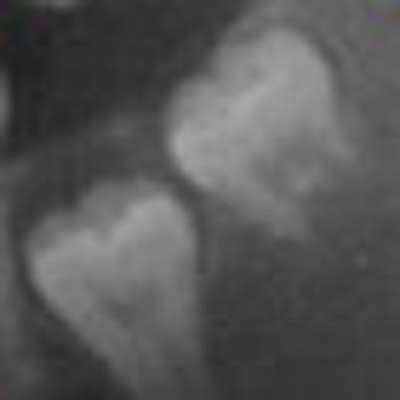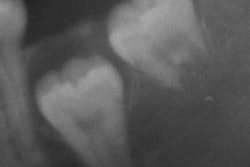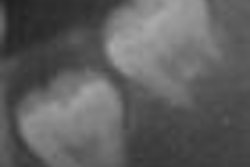
The debate over the benefits of extracting healthy third molars from young adults has been reinvigorated by research released last week by the American Association of Oral and Maxillofacial Surgeons (AAOMS).
During an October 19 meeting in Washington, D.C., AAOMS brought together an array of experts in the field to present 10 years' worth of data that broadly supports the practice. AAOMS' goal was to settle the matter once and for all with extensive evidence-based research, according to Louis Rafetto, D.M.D., chair of the AAOMS Task Force on Third Molar Data.
"We wanted the perspective of a variety of people," he said. "Researchers from the U.K., Canada, Scandinavia, and around the U.S. were present, and we had nonclinicians like epidemiologists, periodontists, insurance industry representatives, public health people, oral surgery people, and a military representative at the podium."
Much of the research presented at the meeting focused on the relationship between periodontal disease and third molars. The microbial biofilm associated with partially erupted third molars and pericoronitis emulates periodontal disease, the AAOMS noted. In addition, 25% of patients with asymptomatic retained wisdom teeth have evidence of periodontal disease.
"Even when third molars are not diseased or symptomatic when they come into the oral cavity, their position and location in the mouth makes them difficult to keep clean and supports the accumulation and spread of harmful bacteria that can lead to more serious conditions later in life," the AAOMS noted in a press release announcing the research findings. The local and systemic health implications of asymptomatic wisdom teeth are far broader than previously thought, according to the association.
Larry J. Moore, D.D.S., M.S., president of AAOMS, said the research project was borne out of a need to confirm widely held beliefs about the practice's validity among oral and maxillofacial surgeons.
“The evidence … is even
stronger than we thought it would be.”
— Larry J. Moore, D.D.S, M.S.,
AAOMS president
"My bottom line here is that we went into the funding of this study with no control over the outcome, and we didn't know if it would support our feeling, based on our clinical impression, that taking out asymptomatic wisdom teeth was the right thing to do," he said in an interview with DrBicuspid.com. "It turns out that the evidence that has come from 10 years of examining this issue is even stronger than we thought it would be."
Some of the most valuable information originated from a study by Irja Ventä, D.D.S., Ph.D., of Finland, he noted.
"They have the best longitudinal studies on what happens with patients when you don't take them out of any group," Dr. Moore said. "And her research shows that if you do a life table analysis of people with wisdom teeth, every decade some of those teeth have to be removed because they become pathologic. They either get infected or they develop a cyst or tumor. If you follow people out 18 years, 75% to 80% of those have to be removed, according to her research."
The coin's other side
Despite these findings, the prophylactic removal of third molars still faces criticism. The American Public Health Association (APHA) determined in 2008 that of the reported risks associated with leaving wisdom teeth in, "none of these contentions is sufficient to support prophylactic extraction."
Meanwhile, the patient version of the ADA's official position (it has no dentist version) neither supports nor opposes the practice: "Wisdom teeth are a valuable asset to the mouth when they are healthy and properly positioned" although "Often ... problems develop." The organization only recommends the removal of third molars when they partially erupt, there is a chance that poorly aligned wisdom teeth will damage adjacent teeth, or a cyst forms.
And while the AAOMS is confident in its position, studies exist with conclusions counter to their claims. "In more than 98% of cases, there is no apparent benefit to prophylactic third-molar extraction in adolescents," wrote Tom Daley, D.D.S., M.Sc., in General Dentistry (July-August 1996, Vol. 44:4, pp. 310-320).
Of all the critics of third-molar removal, Jay Friedman, D.D.S., M.P.H., has been one of the most vocal for more than 30 years. After listening to the AAOMS meeting while it was streamed online, he disputed some of the claims made there.
"I found their conclusions to be spurious, and almost all the studies cited were done by oral surgeons or sponsored by AAOMS," Dr. Friedman told DrBicuspid.com. "We need independent verification."
Dr. Friedman is the author of several papers, including the APHA's policy statement and a paper on the topic published in the American Journal of Public Health (September 2007, Vol. 97:9, pp. 1554-1559). In that article, Dr. Friedman stated that of the 10 million extractions done each year "at least two-thirds of these extractions, associated costs, and injuries are unnecessary, constituting a silent epidemic of iatrogenic injury that afflicts tens of thousands of people with lifelong discomfort and disability."
"That was the basis of my article," Dr. Friedman recalled. "In the meantime, since they didn't have enough justification to take out 100% of wisdom teeth, they've gotten onto this kick about periodontal disease, a big feature of the conference. It raises an interesting dilemma because almost all the studies that have been published have been in the Journal of Oral and Maxillofacial Surgery, but virtually none in periodontal journals."
Periodontists' view
The American Academy of Periodontology (AAP) does not have an official position, but Samuel Low, D.D.S., M.S., president of the academy also attended the conference.
"For us periodontists, I believe risk is a crucial factor," Dr. Low told DrBicuspid.com. "We at the academy don't think they all should be removed; we have to use discretion. I've seen the damage that has been done to second molars by keeping third molars. One of the first places we see periodontal disease is in between the second and third molars, and due to their anatomical position, significant gum disease there is extremely difficult to treat surgically."
Dr. Low acknowledged the difficult nature of cleaning third molars was as an important aspect of the discussion at the AAOMS meeting, and added that "for patients already susceptible to gum disease, it's a risk not to remove third molars."
Dr. Moore argued that periodontists were appropriately involved in the AAOMS-sponsored research.
"The periodontists who were involved in these studies are fully on board with the idea that the wisdom tooth is difficult to maintain and that if you probe it, you'll find that it has pathologic probe depths," he explained.
Dr. Friedman disagreed. "What's true for wisdom teeth by their reasoning should be true for other teeth," he responded. "So any tooth with pocket depth greater than 4 mm should be removed?"
Critics contend that the overall risk associated with third molar extractions -- including jaw fractures, damage to the maxillary sinus or to adjacent teeth, and the infrequent death caused by anesthesia -- is an aspect of the debate that is glossed over. In 2008, the APHA estimated that 3.8 million patients account ed for 5 million wisdom tooth extractions annually, and that roughly 17,000 to 50,000 of them experience permanent mandibular nerve paresthesia of varying degrees of severity. TMD/TMJ injuries, some permanent, affect tens of thousands, and pain, swelling, bruising and malaise from typical extractions cause patients to rack up over 10 million days of discomfort and disability annually resulting in missed school and work, according to the organization.
Dr. Moore disagreed. "It was my feeling from being in practice that if you take wisdom teeth out in young, healthy people sometime between age 14 and 16, they can be taken out safely with very little risk, compared to some that claim high rates of injury," he countered. "The real incidents of injury happen preferentially in people over 25 and the rate of injury, in particular nerve injury -- the single worse thing that can happen when you take out wisdom teeth -- is probably less than 1 in 2,500."
It has also been suggested that factors other than health reasons or proprietary efforts have guided the AAOMS' research, such as protecting revenue streams.
"Let me give you this dilemma," Dr. Moore said. "We increasingly are asked in healthcare to provide evidence for what we do. When nobody else out there is willing to fund the research that needs to be done to prove or disprove whether you should do something or not, it becomes incumbent upon the people who have a belief based on their clinical practice that something is a good treatment. Then they have to roll the dice."
Dr. Rafetto agreed and offered a personal anecdote.
"I took out my 16-year-old daughter's third molars," he said. "I didn't get paid for that. I did it because it was the right thing to do, and I certainly wouldn't subject a family member to any undue risk of complication. I did it because that's the optimal time in her case. I have to treat people the way I would treat family members."
Copyright © 2010 DrBicuspid.com



















